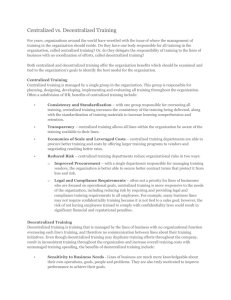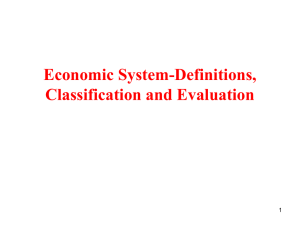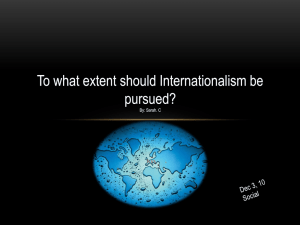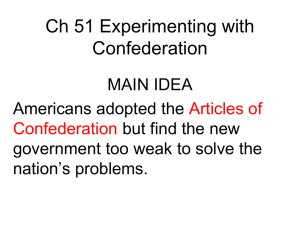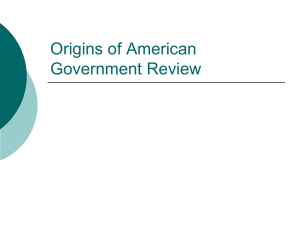The Statement
advertisement
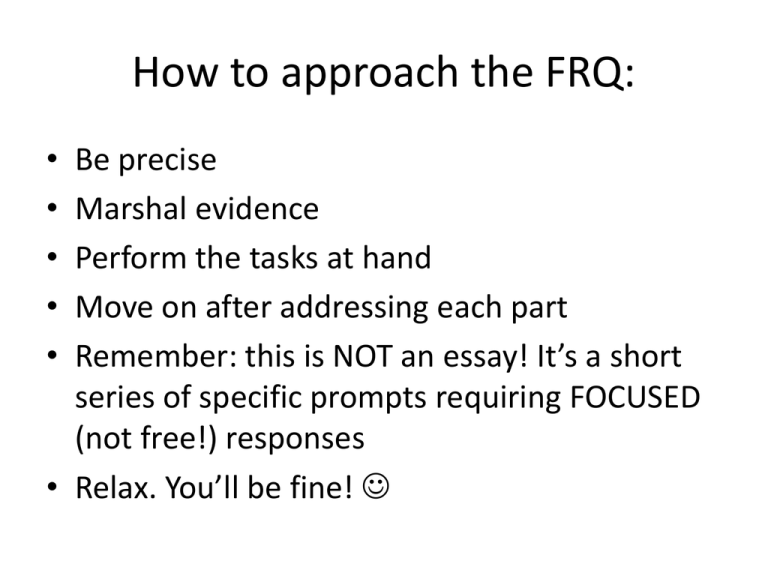
How to approach the FRQ: • • • • • Be precise Marshal evidence Perform the tasks at hand Move on after addressing each part Remember: this is NOT an essay! It’s a short series of specific prompts requiring FOCUSED (not free!) responses • Relax. You’ll be fine! The Statement “The Constitution created a federal government in order to address problems of decentralization that were experienced under the Articles of Confederation.” - Note: this is NOT a question; it’s a statement. It gives you a general idea of the theme you’ll be asked to address. Part (a): “Define federalism.” Your only task here is to provide a definition. There is no need for an introduction, a thesis, or any other musing on politics or history. Sample response: Federalism is a system of government in which the power to govern is shared between a central authority and smaller state and local authorities. Then, MOVE ON! Part (b): “List three problems of decentralized power that existed under the Articles of Confederation. For each problem you list, identify one solution that the Constitution provides to address the problem.” What you have to do is straightforward and simple. You are not writing an essay about the weaknesses of the Articles of Confederation or a veneration of the Constitution. You are essentially providing two lists – for each, a series OR bullet points will suffice. Let’s take one piece of this at a time. Part (b) continued: “List three problems of decentralized power that existed under the Articles of Confederation.” Sample response: Three problems of decentralized power under the Articles were: -no power to tax -no power to raise an army -no centralized court system Part (b) continued: “For each problem you list, identify one solution that the Constitution provides to address the problem.” Sample response: The Constitution resolved these problems by: -giving Congress the power to tax -making the President Commander in Chief of the military -creating a system of federal courts Then, MOVE ON! Part (c): “Some have argued that the tensions between decentralized and centralized power continue to exist. Support this argument by explaining how one of the following illustrates the continuing tension.” • Education reform • Gun control • Welfare reform Your job here is to use evidence to back up the claim being made in part (c) that tensions still exist. You can NOT simply cite a legal case or a law; you must explain the connection between the legal case or law and the policy area (i.e. education reform, gun control, welfare reform) you’ve selected. Part (c) continued: “Some have argued that the tensions between decentralized and centralized power continue to exist. Support this argument by explaining how one of the following illustrates the continuing tension.” Sample response (education reform): The No Child Left Behind Act, passed in 2001, illustrates this tension because it gives the federal government more authority over the domain of education than ever before in US history. Previously, education was a reserved power -- it had always been a domain governed by the states and localities alone. Part (c) continued: “Some have argued that the tensions between decentralized and centralized power continue to exist. Support this argument by explaining how one of the following illustrates the continuing tension.” Sample response (gun control): Many pieces of legislation, from the Gun Free School Zones Act to the Brady Act, have attempted to federally restrict the ownership and possession of firearms. In each case, lawsuits have tested the constitutionality of these federal restrictions and resulted in compromises between federal and state authorities, illustrating the continued tensions between the two. Part (c) continued: “Some have argued that the tensions between decentralized and centralized power continue to exist. Support this argument by explaining how one of the following illustrates the continuing tension.” Sample response (welfare reform): In 1996, the Welfare Reform Act was passed, which transferred a great deal of authority from the federal government to the states in the distribution of social welfare. This type of devolution illustrates the continued tensions and changing balance of power and responsibility between the state and federal governments.
